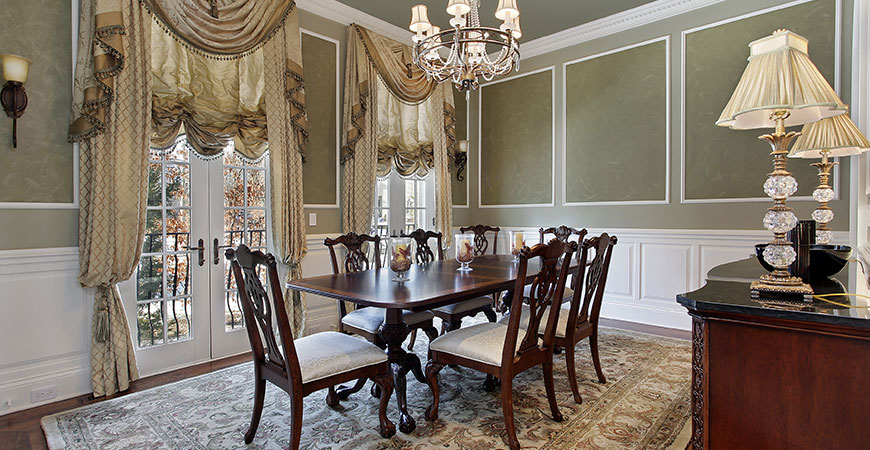
It is often stated that if you want to know where you are going, you need first to understand where you come from. This same philosophy applies to the evolving trends in home décor; and more specifically, that of crown molding. Because crown molding is a finish with a remarkable history, it is interesting to understand how the finish has reinvented itself over the years. In so doing, you can best integrate crown molding in your home in a way that is either classic, contemporary or somewhere in between.
Crown Molding in Ancient Times
When we typically speak about the history of crown molding, we tend to trace this history back only so far as the nineteenth century. But, to put this finish in context, we see that crown moldings upheld an important presence even in Ancient times.
The ancient Greeks and Romans often incorporated crown moldings in their homes and public venues. At this time, crown moldings adopted curved shapes and designs. For example, the parabola and the ellipse became the predominant shapes around which moldings were designed. Over time, these curved wooden moldings became further simplified and instead incorporated half-moons and quarter round symbols. Crown moldings were then made exclusively of wood, and were used on interiors.
Crown Molding in the Nineteenth Century
Moldings continued to have a strong presence in the interiors of homes; however, this finish experienced a real renaissance during the nineteenth century. Just prior to 1850, carpenters became largely employed to construct ornate crown moldings on site. Indeed, these carpenters were hired to create ornate and highly decorative moldings. Using chisels, gouges and hand planes carpenters would create intricate dentil moldings. From here, increasingly intricate styles began to crop up, and homeowners had the option to choose the moldings that best represented their design preferences.
Crown Moldings in Contemporary Context
If you are hoping to incorporate crown moldings in your home, there are now a wealth of options from which to choose. In fact, there are well over a hundred styles that are readily available at your local hardware store. But now crown moldings are used in much more variegated ways.
For example, crown moldings are no longer uses simply as cornices. Contemporary homeowners often select moldings with which to create decorative borders around architectural finishes. If your living room is blessed with a built in bookshelf, for instance, you may want to create a defined border around it. Simple, minimalist moldings can be used to create a contemporary border around this feature, too. Crown moldings can also be employed to create a mantel above your home fireplace. Cutting molding into shorter pieces, and laying them artistically on your wall, for instance, is an excellent way of creating an interesting interior focal point.
In addition, many homeowners now use crown moldings on the exterior of their homes.
Sometimes you will see treated moldings used to create a border around a Victorian home’s wrap-around porch. Alternatively, moldings are sometimes used to establish a more defined border around a home’s windows. Using molding in this way takes a generic window to one that is personalized and unique. If you are interested in using moldings in these ways, you will want to make sure that you treat the wood with a sealant. As such, they will withstand the wear and tear attached to harsh weather conditions.
Contemporary Materials
As mentioned, crown moldings were traditionally made of wood. But, in our contemporary moment, moldings are made out of a much more diverse selection of materials. In addition to wood, many homeowners are pleasantly surprised to learn that crown moldings can be made of polyurethane as well. The main benefit of polyurethane is that it is pliable in nature. As such, polyurethane moldings become the ideal finish in any curved space. Now more than ever homeowners have the ability to add a sense of dimension, structure and balance in their curved spaces.
Other contemporary crown moldings are made out of tin and aluminum. Moldings comprised of these metals lend a real sense of contemporaneity to any space. Because these metals pick up and reflect light—sparkling all the while—they appear highly valuable. Metal moldings look beautiful next to hammered metal ceiling panels. Although many homeowners opt to use tin or aluminum moldings in an otherwise minimalist space, garnished with very few accessories.
All in all, crown moldings have had a long and seasoned history. In ancient times, these moldings were used in curved shapes and designs as cornices inside the home. By the nineteenth century, carpenters were hired to create ornate wood moldings that would be installed within the home. Today, moldings can adopt either of these forms or other more streamlined silhouettes. Determine what sort of impression you want to establish, and select your molding accordingly.
